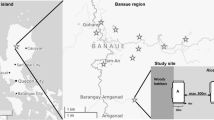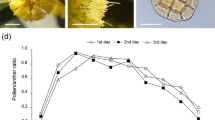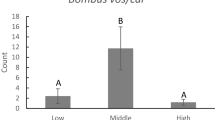Abstract
Our understanding of the effects of introduced invasive pollinators on plants has been exclusively drawn from studies on introduced social bees. One might expect, however, that the impacts of introduced solitary bees, with much lower population densities and fewer foragers, would be small. Yet little is known about the potential effects of naturalized solitary bees on the environment. We took advantage of the recent naturalization of an orchid bee, Euglossa viridissima, in southern Florida to study the effects of this solitary bee on reproduction of Solanum torvum, an invasive shrub. Flowers of S. torvum require specialized buzz pollination. Through timed floral visitor watches and two pollination treatments (control and pollen supplementation) at three forest edge and three open area sites, we found that the fruit set of S. torvum was pollen limited at the open sites where the native bees dominate, but was not pollen limited at the forest sites where the invasive orchid bees dominate. The orchid bee’s pollination efficiency was nearly double that of the native halictid bees, and was also slightly higher than that of the native carpenter bee. Experiments using small and large mesh cages (to deny or allow E. viridissima access, respectively) at one forest site indicated that when the orchid bee was excluded, the flowers set one-quarter as many fruit as when the bee was allowed access. The orchid bee was the most important pollinator of the weed at the forest sites, which could pose additional challenges to the management of this weed in the fragmented, endangered tropical hardwood forests in the region. This specialized invasive mutualism may promote populations of both the orchid bee and this noxious weed. Invasive solitary bees, particularly species that are specialized pollinators, appear to have more importance than has previously been recognized.



Similar content being viewed by others
References
Armbruster WS (1988) Multilevel comparative analysis of the morphology, function, and evolution of Dalechampia blossoms. Ecology 69:1746–1761
Ashman TL, Knight TM, Steets JA, Amarasekare P, Burd M, Campbell DR, Dudash MR, Johnston MO, Mazer SJ, Mitchell RJ, Morgan MT, Wilson WG (2004) Pollen limitation of plant reproduction: ecological and evolutionary causes and consequences. Ecology 85:2408–2421
Barthell JF, Randall JM, Thorp RW, Wenner AM (2001) Promotion of seed set in yellow star-thistle by honey bees: evidence of an invasive mutualism. Ecol Appl 11:1870–1883
Buchmann SL (1983) Buzz pollination in angiosperms. In: Jones CE, Little RJ (eds) Handbook of experimental pollination biology (scientific and academic editions). Van Nostrand, New York, pp 73–113
Burd M (1994) Bateman’s principle and plant reproduction: the role of pollen limitation in fruit and seed set. Bot Rev 60:83–139
Butz Huryn VM (1997) Ecological impacts of introduced honey bees. Q Rev Biol 72:275–297
Dafni A, Shmida A (1996) The possible ecological implications of the invasion of Bombus terrestris (L.) (Apidae) at Mt. Carmel, Isreal. In: Matheson AC, Buchmann SL, O’Toole C (eds) The conservation of bees. The Linnean Society of London and the International Bee Research Association, London, pp 183–200
DuPont YL, Hansen DM, Valido A, Olesen JM (2004) Impact of introduced honey bees on native pollination interactions of the endemic Echium wildpretii (Boraginaceae) on Tenerife, Canary Islands. Biol Conserv 118:301–311
Goulson D (2003) Effects of introduced bees on native ecosystems. Ann Rev Ecol Evol S 34:1–26
Groom MJ (1998) Allee effects limit population viability of an annual plant. Am Nat 151:487–496
Gross CL, Mackay D (1998) Honeybees reduce fitness in the pioneer shrub Melastoma affine (Melastomataceae). Biol Conserv 86:169–178
Hingston AB, McQuillan PB (1999) Displacement of Tasmanian native megachilid bees by the recently introduced bumblebee Bombus terrestris (Linnaeus, 1758) (Hymenoptera: Apidae). Aust J Zool 47:59–65
Hingston AB, Potts BM, McQuillan PB (2004) Pollination services provided by various size classes of flower visitors to Eucalyptus globulus ssp. globulus (Myrtaceae). Aust J Bot 52:353–369
Langeland KA, Craddock Burks K (1998) Identification and biology of non-native plants in Florida’s native areas. University of Florida, Gainesville
Larson BMH, Barrett SCH (2000) A comparative analyses of pollen limitation in flowering plants. Biol L Linnean Soc 69:503–520
Morales CL, Aizen MA (2002) Does invasion of exotic plants promote invasion of exotic flower visitors? A case study from the temperate forests of the southern Andes. Biol Invasions 4:87–100
Nadel H, Frank H, Knight RJ (1992) Escapees and accomplishes: the naturalization of exotic Ficus and their associated faunas in Florida. Fla Entomol 75:29–39
Natural Resources Conservation Service (2002) Federal noxious weed list. Natural Resources Conservation Service, USDA, Washington. http://plants.usda.gov/java/noxious?rptType=Federal, last accessed 24 Nov 2008
Olsen KM (1997) Pollination effectiveness and pollinator importance in a population of Heterotheca subaxillaris (Asteraceae). Oecologia 109:114–121
Paini DR, Roberts JD (2005) Commercial honey bees (Apis mellifera) reduce the fecundity of an Australian native bee (Hylaeus alcyoneus). Biol Conserv 123:103–112
Parker IM (1997) Pollinator limitation of Cytisus scoparius (scotch broom), an invasive exotic shrub. Ecology 78:1457–1470
Pemberton RW (2008) Pollination of the ornamental Oncidium sphacelatum by the naturalized oil-collecting bee (Centris nitida) in Florida. Selbyana 29:87–91
Pemberton RW, Liu H (2008a) A naturalized orchid bee pollinates resin reward flowers in southern Florida; novel and known mutualisms. Biotropica 40:714–718
Pemberton RW, Liu H (2008b) The naturalization of an oil collecting bee Centris nitida in Florida and the eastern United States, with notes on the Centris species native to Florida. Florida Entomol 91:101–109
Pemberton RW, Liu H (2008c) Potential of invasive and native solitary specialist bee pollinators to help restore the rare cowhorn orchid (Cyrtopodium punctatum) in Florida. Biol Conserv 141:1758–1760
Pemberton RW, Wheeler GS (2006) Orchid bees don’t need orchids, evidence from the naturalization of an orchid bee in Florida. Ecology 87:1995–2001
Potts SG, Dafni A, Ne’eman G (2001) Pollination of a core flowering shrub species in Mediterranean phrygana: variation in pollinator diversity, abundance and effectiveness in response to fire. Oikos 92:71–80
Roubik DW (1978) Competitive interactions between neotropical pollinators and Africanized honey bees. Science 201:1030–1032
Roubik DW, Hanson PE (2004) Orchid bees of tropical America: biology and field guide. Instituto Nacional de Biodiversidad, San Jose
Skov C, Wiley J (2005) Establishment of the Neotropical orchid bee Euglossa viridissima (Hymenoptera: Apidae) in Florida. Fla Entomol 88:225–227
Small JK (1933) Manual of the southeastern flora. University of North Carolina Press, Chapel Hill
Stokes KE, Buckley YM, Sheppard AW (2006) A modeling approach to estimate the effect of exotic pollinators on exotic weed population dynamics: bumblebees and broom in Australia. Biodivers Res 12:593–600
Stout JC, Kells AR, Goulson D (2002) Pollination of the invasive exotic shrub Lupinus arboreus (Fabaceae) by introduced bees in Tasmania. Biol Conserv 106:425–434
Thomson D (2004) Competitive interactions between the invasive European honey bee and native bumble bees. Ecology 85:458–470
Traveset A, Richardson D (2006) Biological invasions as disruptors of plant reproductive mutualisms. Trends Ecol Evol 21:208–216
Vázquez DP, Aizen MA (2004) Asymmetric specialization: a pervasive feature of plant–pollinator interactions. Ecology 85:1251–1257
Whalen MD, Costich DE (1986) Andromonoecy in Solanum. In: D’Arcy WG (ed) Solanaceae biology and systematics. Columbia University Press, New York, pp 284–302
Wunderlin RP, Hansen BF (2003) Guide to the vascular plants of Florida. The University Press of Florida, Gainesville
Zar J (1998) Biostatistical analysis, 4th edn. Prentice Hall, Upper Saddle River
Acknowledgments
We thank Gloria Witkus, Judy Wu, and Rachel Taylor for field assistance, the owners of the Weekley Brothers Ranch for permission to work there, Patricia Howell of Broward County for protecting one of the S. torvum populations studied from Broward County’s eradication efforts. David Goulson, Andrew Hingston and three anonymous reviewers provided insightful comments on earlier drafts of the manuscript.
Author information
Authors and Affiliations
Corresponding author
Additional information
Communicated by Steven Johnson.
Electronic supplementary material
Below is the link to the electronic supplementary material.
Rights and permissions
About this article
Cite this article
Liu, H., Pemberton, R.W. Solitary invasive orchid bee outperforms co-occurring native bees to promote fruit set of an invasive Solanum . Oecologia 159, 515–525 (2009). https://doi.org/10.1007/s00442-008-1232-6
Received:
Accepted:
Published:
Issue Date:
DOI: https://doi.org/10.1007/s00442-008-1232-6




